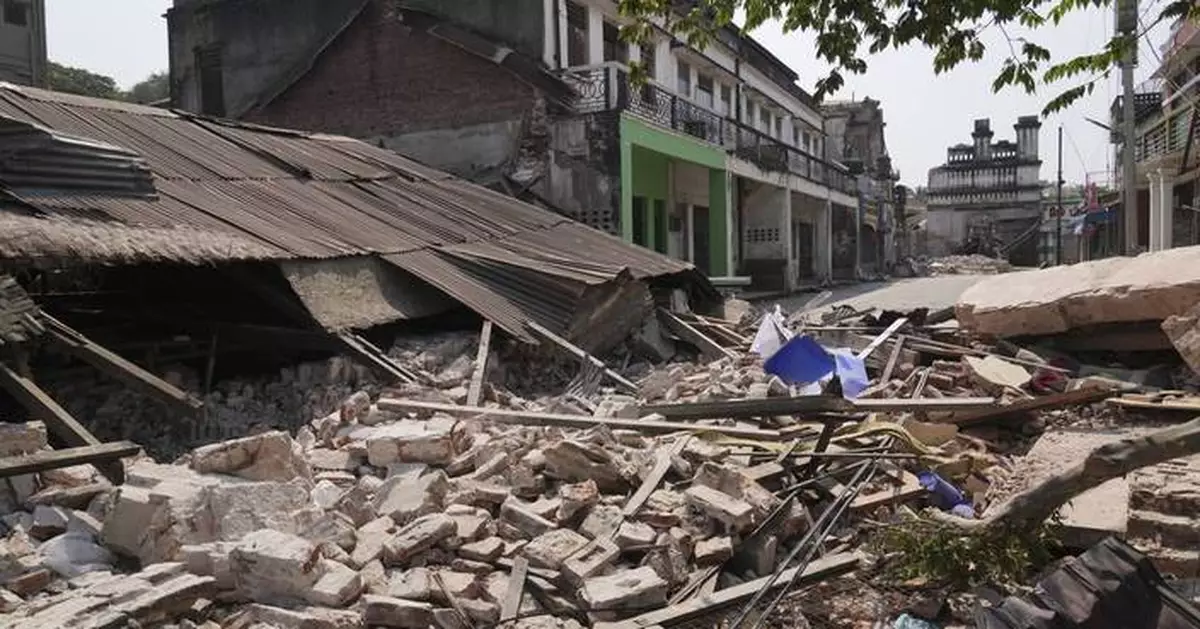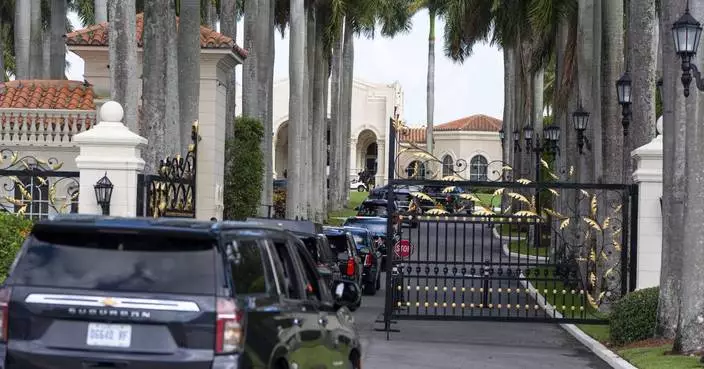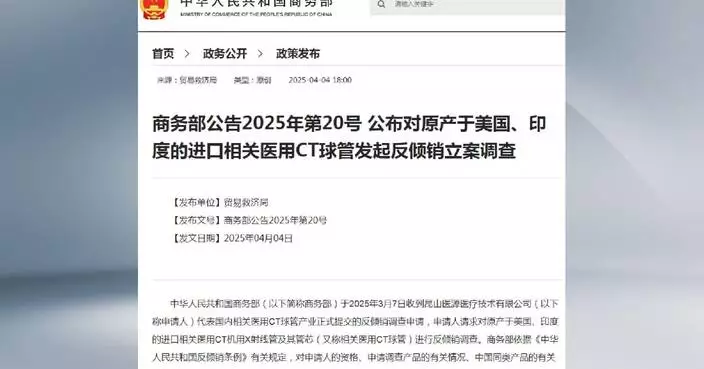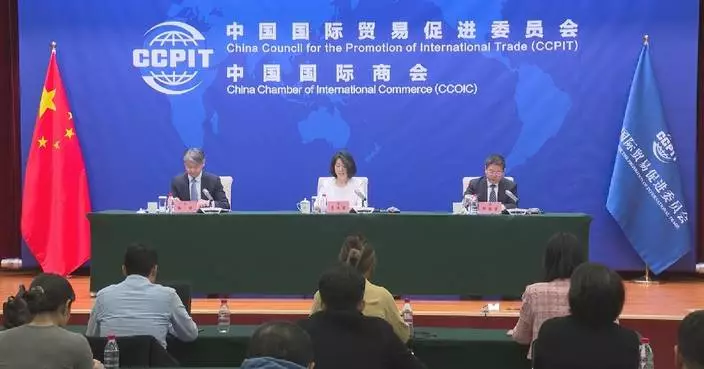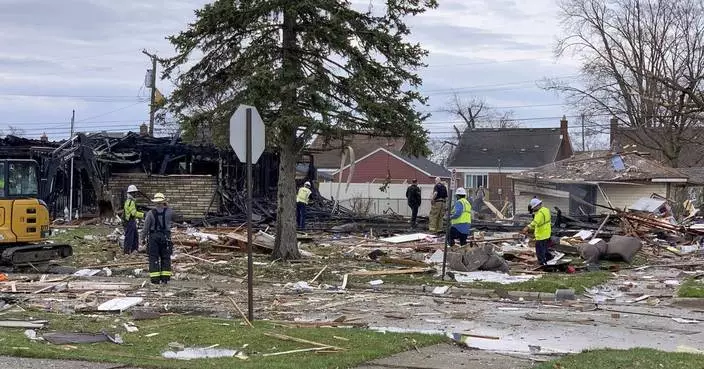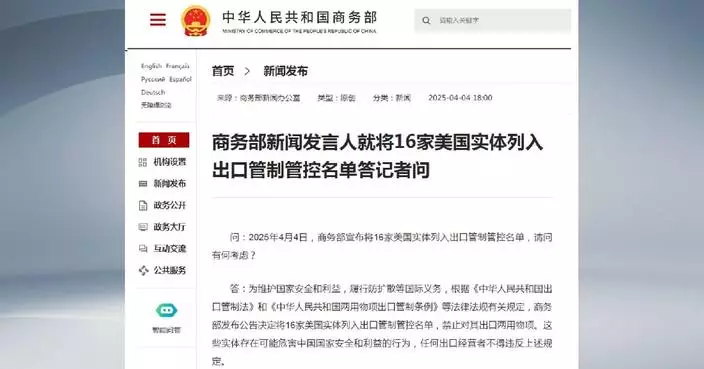BANGKOK (AP) — The Southeast Asian nation of Myanmar has been plagued by wars and natural disasters since it became independent from Britain in 1948, when it was still called Burma.
Relief efforts from Friday’s devastating 7.7 magnitude earthquake will be especially complicated with the country in embroiled in civil war, which began after the army seized power from the elected government of Aung San Suu Kyi in February 2021.
Click to Gallery
Damaged buildings are seen in the aftermath of an earthquake in Naypyitaw, Myanmar, Sunday, March 30, 2025. (AP Photo/Aung Shine Oo)
Damaged buildings are seen in the aftermath of an earthquake in Naypyitaw, Myanmar, Sunday, March 30, 2025. (AP Photo/Aung Shine Oo)
A car covered by a collapsed building due to the earthquake in Naypyitaw, Myanmar, Sunday, March 30, 2025. (AP Photo/Aung Shine Oo)
In this photo taken from video released by Russian Emergency Ministry Press Service on Sunday, March 30, 2025, Russian Emergency Ministry planes are parked in Myanmar airport, as they arrive to help the country following Friday's earthquake, in Mandalay, Myanmar. (Russia Emergency Ministry press service via AP)
Damaged buildings are seen in the aftermath of an earthquake in Naypyitaw, Myanmar, Sunday, March 30, 2025. (AP Photo/Aung Shine Oo)
A local man rides a bicycle past a damaged building in the aftermath of an earthquake, in Naypyitaw, Myanmar, Sunday, March 30, 2025. (AP Photo/Aung Shine Oo)
Damaged buildings are seen in the aftermath of an earthquake in Naypyitaw, Myanmar, Sunday, March 30, 2025. (AP Photo/Aung Shine Oo)
A local man drives a motorbike past damaged buildings in the aftermath of an earthquake in Naypyitaw, Myanmar, Sunday, March 30, 2025. (AP Photo/Aung Shine Oo)
Damaged buildings are seen in the aftermath of an earthquake in Naypyitaw, Myanmar, Sunday, March 30, 2025. (AP Photo/Aung Shine Oo)
Damaged buildings are seen in the aftermath of an earthquake in Naypyitaw, Myanmar, Sunday, March 30, 2025. (AP Photo/Aung Shine Oo)
The main resistance movement against military rule has issued a statement saying it is unilaterally initiating a two-week ceasefire beginning Sunday in areas of the country affected by the quake.
There was no immediate reaction from the military government, which even before the earthquake — in addition to employing massive repression and state violence — heavily restricted much-needed aid to the more than 3 million people displaced by war.
The army’s ability to facilitate or block food and other assistance has been described as a way of weaponizing aid. Critics of the military government have called repeatedly for outside assistance to be delivered directly to areas under control of the resistance.
The military, which has directly or indirectly ruled Myanmar most of the time since independence, seized power from Suu Kyi’s government as it was about to begin a second five-year term. She and leaders of her National League for Democracy party were jailed, and security forces put down pro-democracy demonstrations with deadly force, leading to the growth of armed resistance, and the army in turn escalating its violence.
Despite a huge disadvantage in weaponry and manpower, pro-democracy fighters allied with ethnic minority groups seeking greater autonomy have successfully battled back, and analysts believe they control a much greater share of territory.
The resistance is coordinated by the self-styled National Unity Government, whose claim to legitimacy is that it was formed by elected lawmakers. The NUG, which operates underground, has an armed wing called the People's Defense Force.
The PDF is largely a conglomeration of locally formed defense groups, poorly armed but usually with the advantage of fighting on home ground. Their ethnic allies are much more experienced and have even managed in some cases to manufacture their own weapons.
The National Unity Government said in an announcement Saturday that the PDF will implement a two-week pause in offensive military operations starting Sunday in earthquake-affected areas, while retaining the right to self-defense.
It said it would collaborate with the U.N. and international nongovernmental organizations "to ensure security, transportation, and the establishment of temporary rescue and medical camps,” in the areas it controls. It also offered to provide health care professionals loyal to its resistance movement to work with international humanitarian organizations to deliver emergency rescue and medical services in areas under the military’s control, if provided with safety guarantees.
The PDF fighters rarely mount large-scale offensives, sticking mainly to defense and ambush-style attacks, so its ceasefire would be largely symbolic. By taking the moral high ground, it gives its supporters a stronger argument to push for the unrestricted distribution of aid.
Although the military government has made the rare gesture of soliciting foreign emergency aid, its critics are skeptical that it will deploy it fairly and effectively.
The military’s record is discouraging. For instance, it initially refused to allow in foreign rescue teams or many emergency supplies after Cyclone Nargis in 2008, which resulted in well over 100,000 deaths, and tens of thousands more left unaccounted for. Even after it agreed to accept foreign help, it was with severe restrictions.
When Cyclone Mocha ripped into the coast in May 2023, the military's relief efforts were again tardy, and as in 2008, private relief missions were discouraged, as was reporting. Property damage was heavy and while 145 deaths were officially acknowledged, independent accounts put the total at over 400.
There are examples in other countries when the effort to rebuild after natural disasters have played a part in helping to restore peace to areas torn by conflict, most notably in Indonesia’s Aceh province after it was devastated by the 2004 Indian Ocean tsunami.
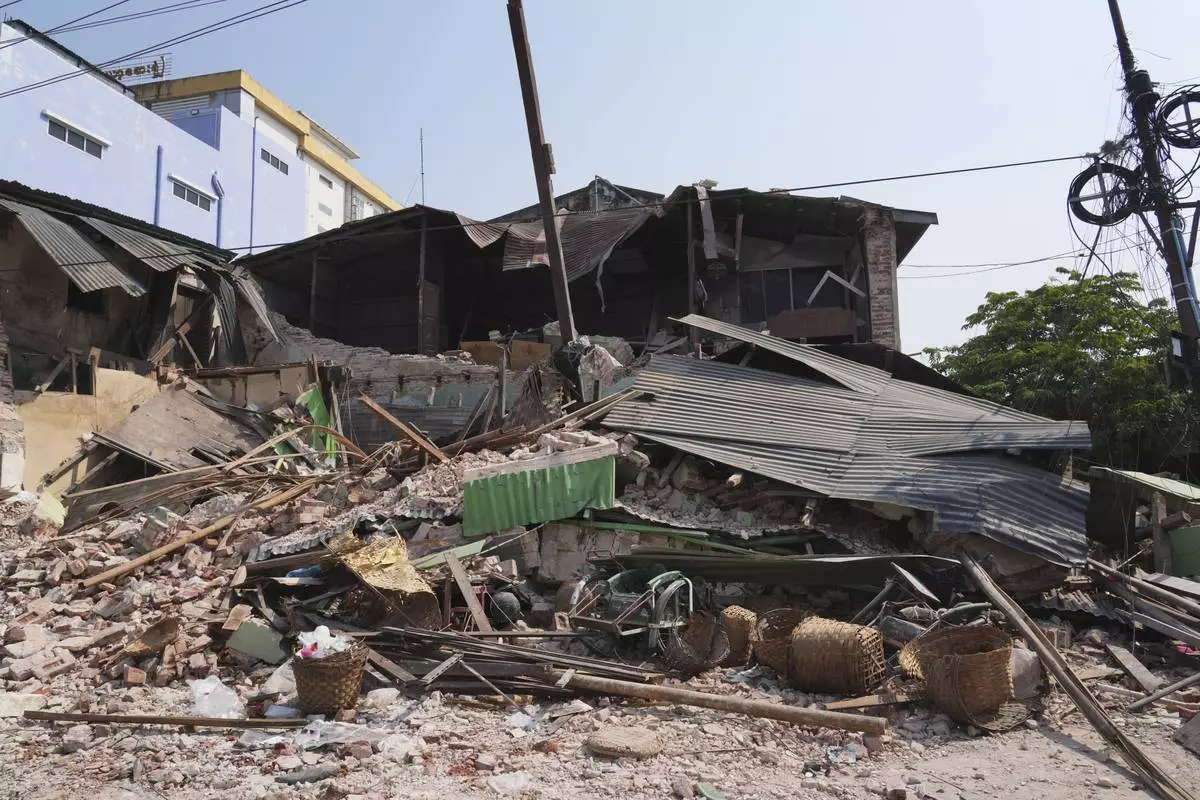
Damaged buildings are seen in the aftermath of an earthquake in Naypyitaw, Myanmar, Sunday, March 30, 2025. (AP Photo/Aung Shine Oo)
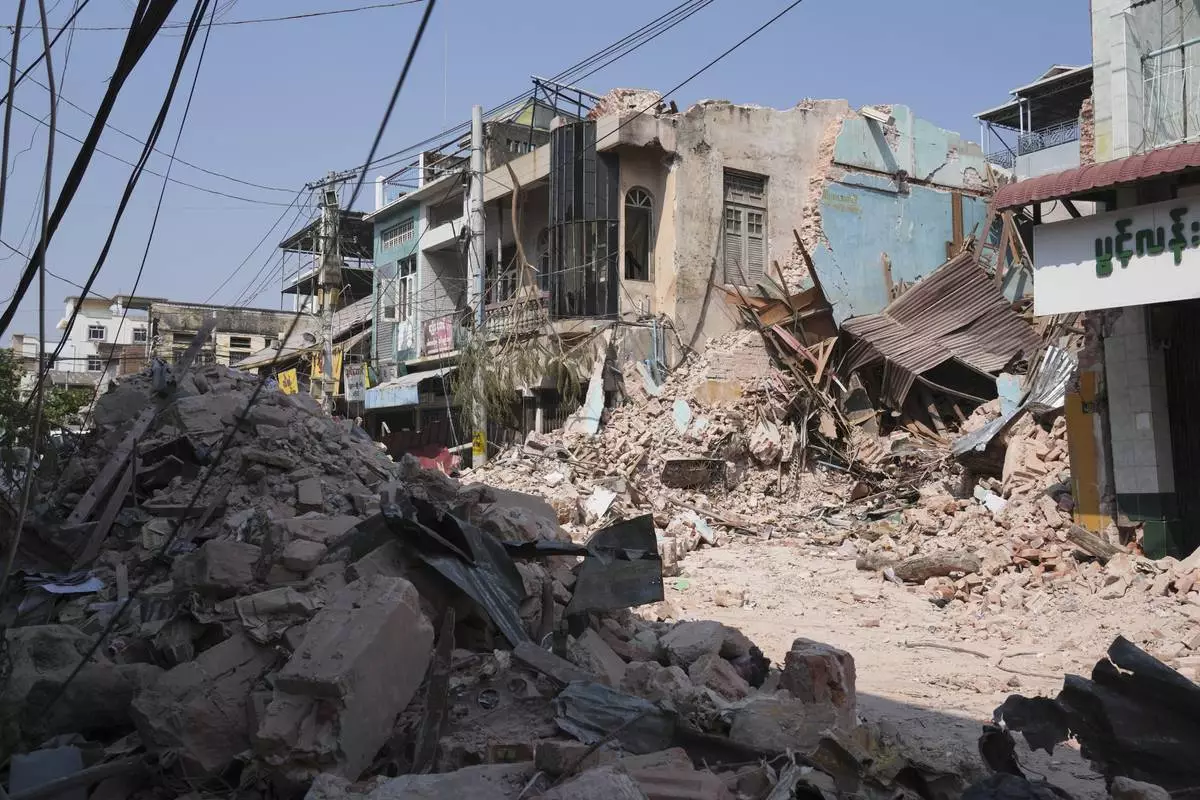
Damaged buildings are seen in the aftermath of an earthquake in Naypyitaw, Myanmar, Sunday, March 30, 2025. (AP Photo/Aung Shine Oo)
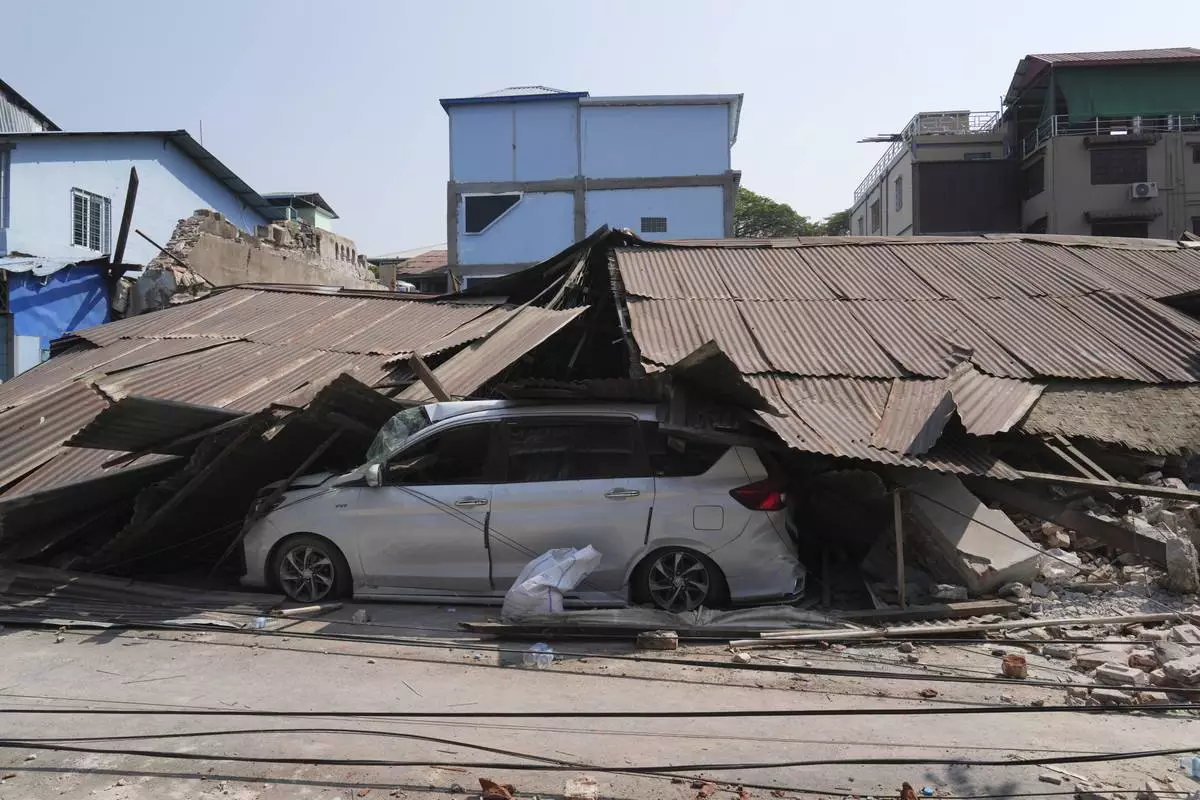
A car covered by a collapsed building due to the earthquake in Naypyitaw, Myanmar, Sunday, March 30, 2025. (AP Photo/Aung Shine Oo)
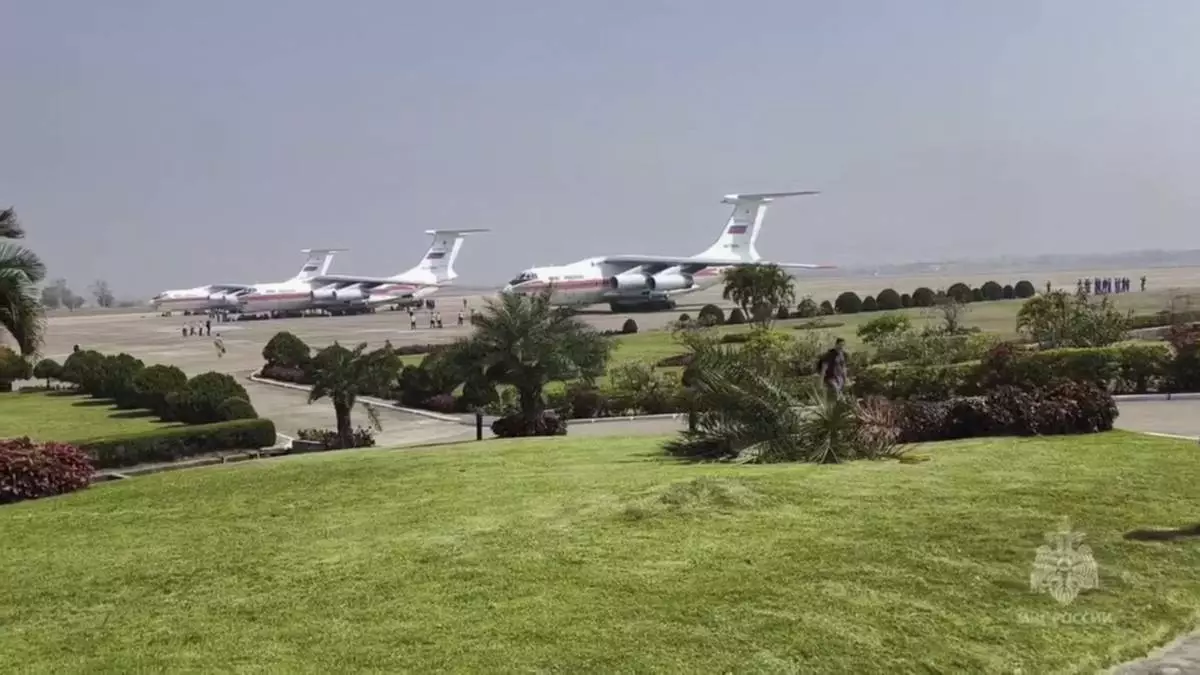
In this photo taken from video released by Russian Emergency Ministry Press Service on Sunday, March 30, 2025, Russian Emergency Ministry planes are parked in Myanmar airport, as they arrive to help the country following Friday's earthquake, in Mandalay, Myanmar. (Russia Emergency Ministry press service via AP)
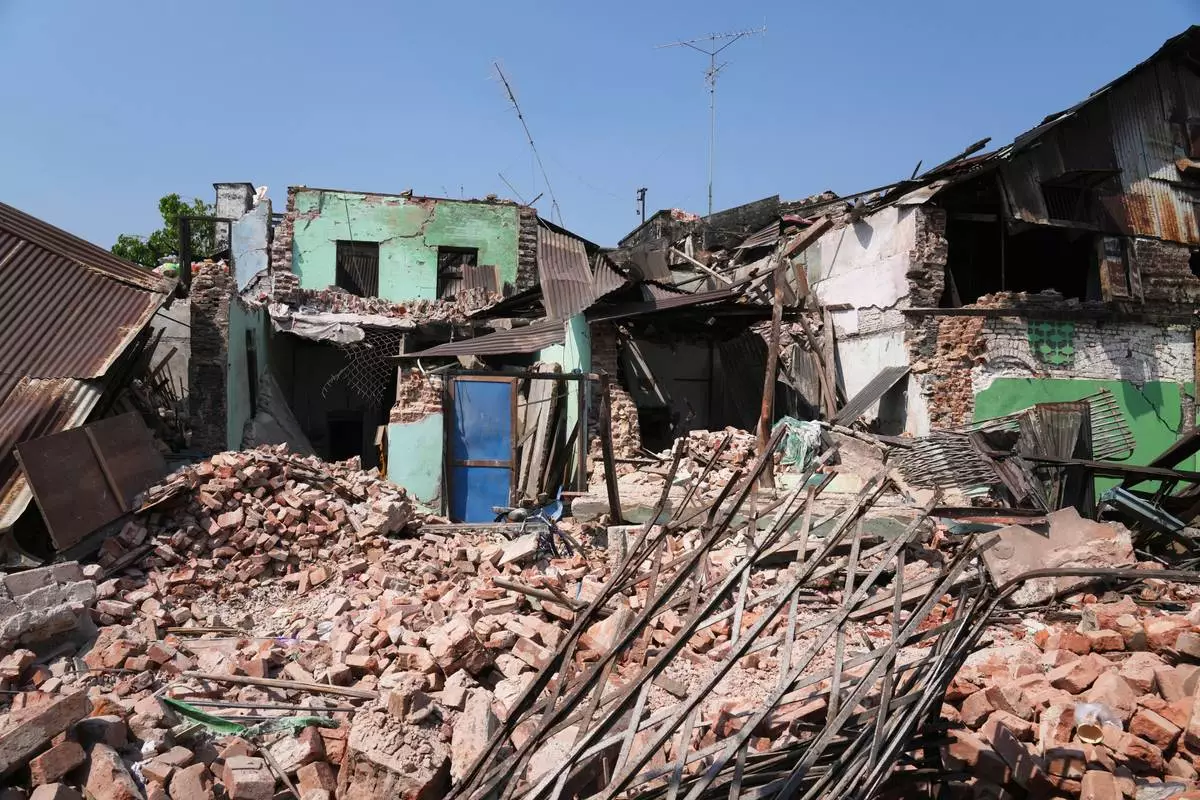
Damaged buildings are seen in the aftermath of an earthquake in Naypyitaw, Myanmar, Sunday, March 30, 2025. (AP Photo/Aung Shine Oo)
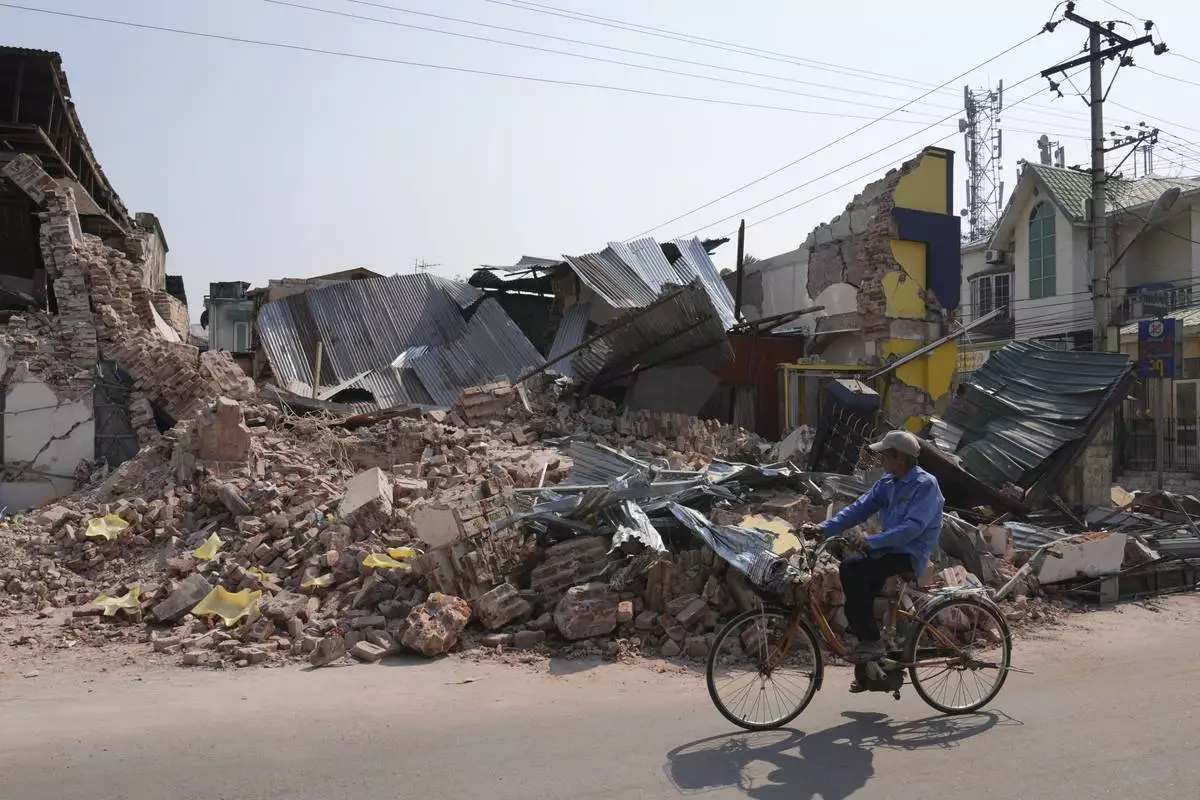
A local man rides a bicycle past a damaged building in the aftermath of an earthquake, in Naypyitaw, Myanmar, Sunday, March 30, 2025. (AP Photo/Aung Shine Oo)
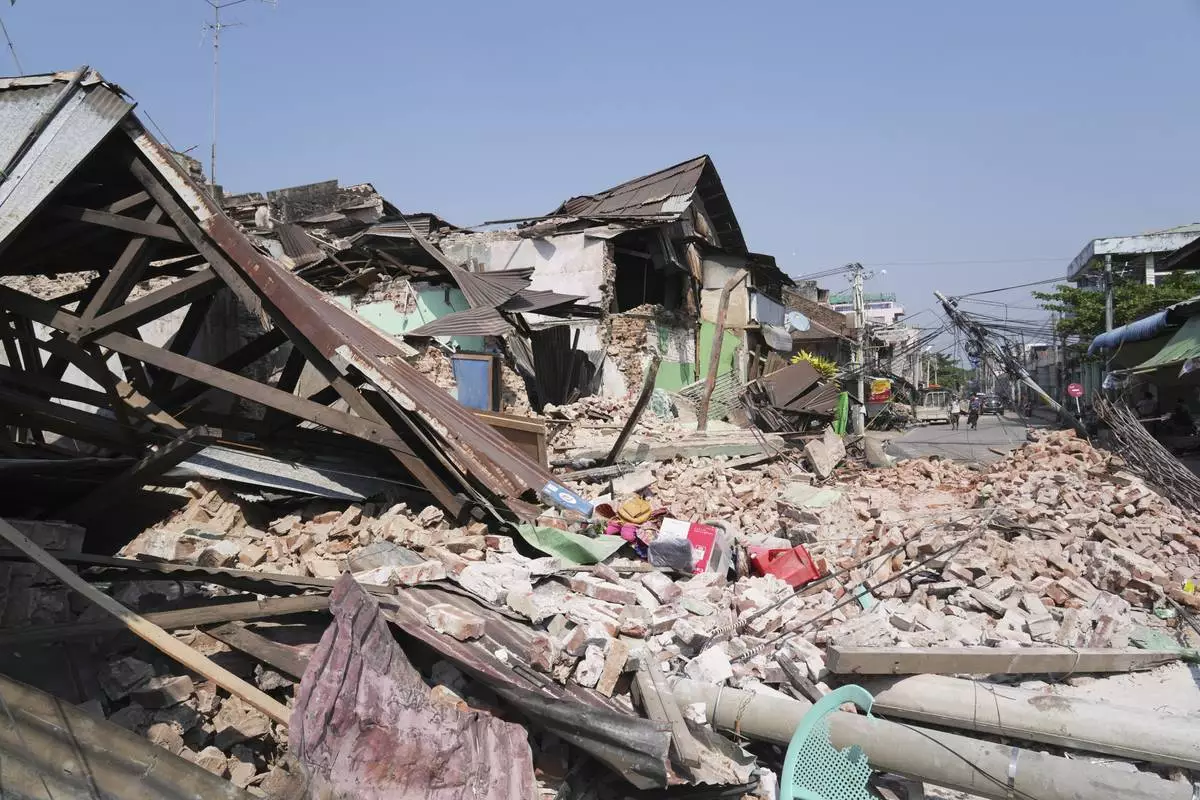
Damaged buildings are seen in the aftermath of an earthquake in Naypyitaw, Myanmar, Sunday, March 30, 2025. (AP Photo/Aung Shine Oo)
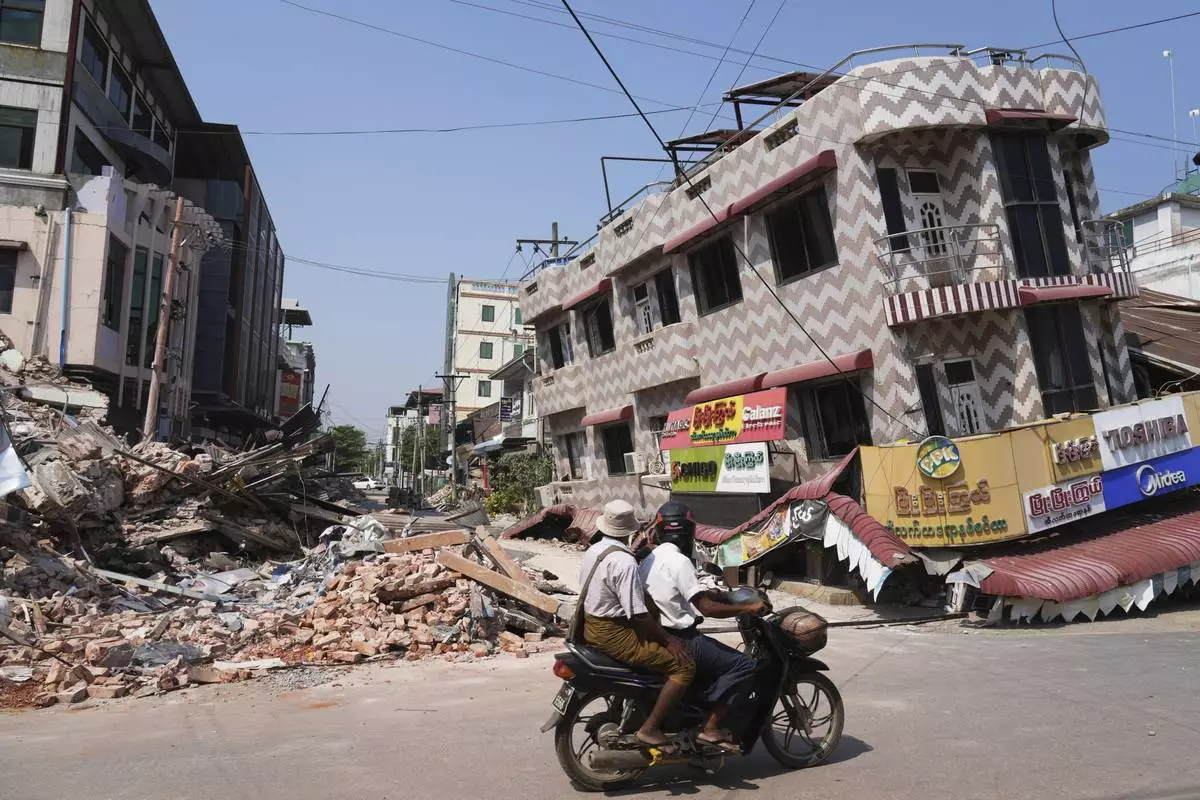
A local man drives a motorbike past damaged buildings in the aftermath of an earthquake in Naypyitaw, Myanmar, Sunday, March 30, 2025. (AP Photo/Aung Shine Oo)
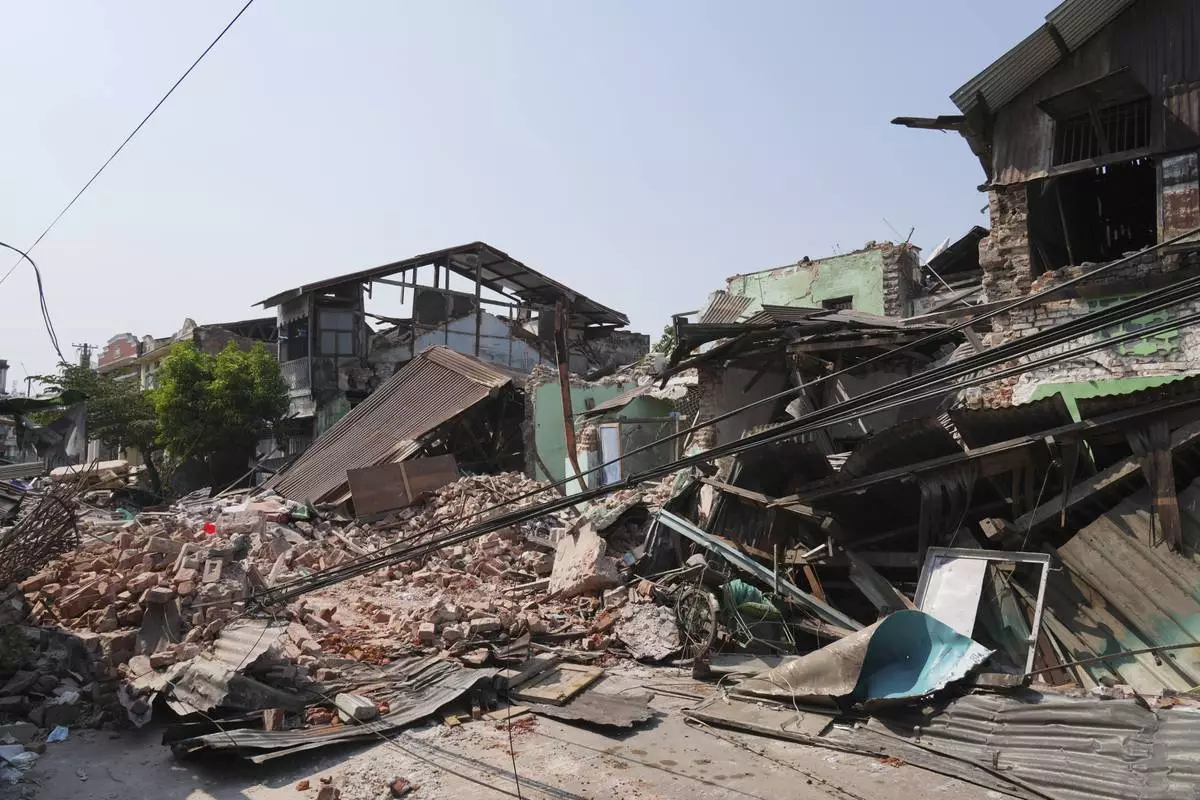
Damaged buildings are seen in the aftermath of an earthquake in Naypyitaw, Myanmar, Sunday, March 30, 2025. (AP Photo/Aung Shine Oo)
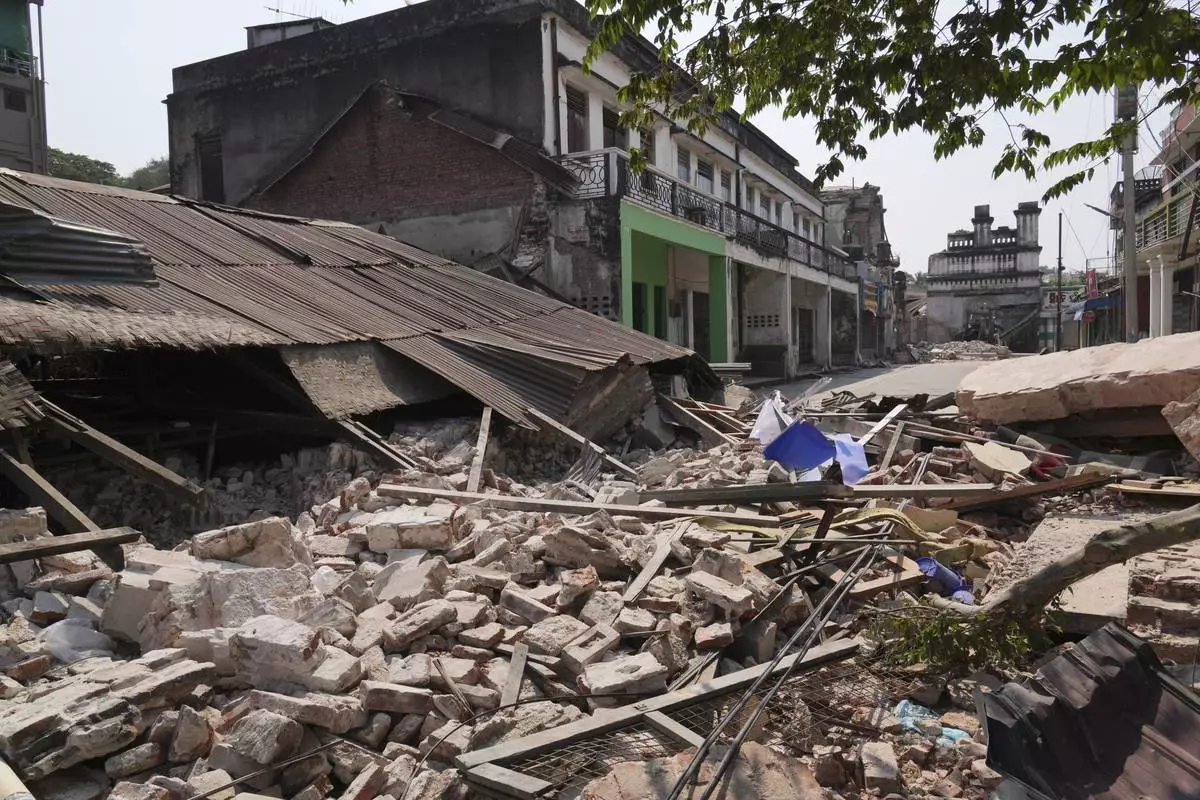
Damaged buildings are seen in the aftermath of an earthquake in Naypyitaw, Myanmar, Sunday, March 30, 2025. (AP Photo/Aung Shine Oo)
NEW YORK (AP) — Wall Street’s worst crisis since COVID slammed into a higher, scarier gear Friday.
The S&P 500 lost 6% after China matched President Donald Trump’s big raise in tariffs announced earlier this week. The move increased the stakes in a trade war that could end with a recession that hurts everyone. Not even a better-than-expected report on the U.S. job market, which is usually the economic highlight of each month, was enough to stop the slide.
The drop closed the worst week for the S&P 500 since March 2020, when the pandemic crashed the economy. The Dow Jones Industrial Average plunged 2,231 points, or 5.5% Friday, and the Nasdaq composite tumbled 5.8% to pull more than 20% below its record set in December.
So far there have been few, if any, winners in financial markets from the trade war. Stocks for all but 12 of the 500 companies that make up the S&P 500 index fell Friday. The price of crude oil tumbled to its lowest level since 2021. Other basic building blocks for economic growth, such as copper, also saw prices slide on worries the trade war will weaken the global economy.
China’s response to U.S. tariffs caused an immediate acceleration of losses in markets worldwide. The Commerce Ministry in Beijing said it would respond to the 34% tariffs imposed by the U.S. on imports from China with its own 34% tariff on imports of all U.S. products beginning April 10. The United States and China are the world’s two largest economies.
Markets briefly recovered some of their losses after the release of Friday morning’s U.S. jobs report, which said employers accelerated their hiring by more last month than economists expected. It’s the latest signal that the U.S. job market has remained relatively solid through the start of 2025, and it’s been a linchpin keeping the U.S. economy out of a recession.
But that jobs data was backward looking, and the fear hitting financial markets is about what’s to come.
“The world has changed, and the economic conditions have changed,” said Rick Rieder, chief investment officer of global fixed income at BlackRock.
The central question looking ahead is: Will the trade war cause a global recession? If it does, stock prices will likely need to come down even more than they have already. The S&P 500 is down 17.4% from its record set in February.
Trump seemed unfazed. From Mar-a-Lago, his private club in Florida, he headed to his golf course a few miles away after writing on social media that “THIS IS A GREAT TIME TO GET RICH.”
The Federal Reserve could cushion the blow of tariffs on the economy by cutting interest rates, which can encourage companies and households to borrow and spend. But the Fed may have less freedom to move than it would like.
Fed Chair Jerome Powell said Friday that tariffs could also drive up expectations for inflation. That could prove more damaging than high inflation itself, because it can drive a vicious cycle of behavior that only worsens inflation. U.S. households have already said they’re bracing for sharp increases to their bills.
“Our obligation is to keep longer-term inflation expectations well anchored and to make certain that a one-time increase in the price level does not become an ongoing inflation problem,” Powell said.
That could indicate a hesitance to cut rates because lower rates can give inflation more fuel.
Much will depend on how long Trump’s tariffs stick and what kind of retaliations other countries deliver. Some of Wall Street is holding onto hope that Trump will lower the tariffs after prying out some “wins” from other countries following negotiations.
Trump has given mixed signals on that. On Friday, he said an official from Vietnam said his country already “wants to cut their Tariffs down to ZERO if they are able to make an agreement with the U.S.” Trump also criticized China’s retaliation, saying on his Truth Social platform that “CHINA PLAYED IT WRONG, THEY PANICKED - THE ONE THING THEY CANNOT AFFORD TO DO!”
Trump has said Americans may feel “some pain” because of tariffs, but he has also said the long-term goals, including getting more manufacturing jobs back to the United States, are worth it. On Thursday, he likened the situation to a medical operation, where the U.S. economy is the patient.
“For investors looking at their portfolios, it could have felt like an operation performed without anesthesia,” said Brian Jacobsen, chief economist at Annex Wealth Management.
But Jacobsen also said the next surprise for investors could be how quickly tariffs get negotiated down. “The speed of recovery will depend on how, and how quickly, officials negotiate,” he said.
On Wall Street, stocks of companies that do lots of business in China fell to some of the sharpest losses.
DuPont dropped 12.7% after China said its regulators are launching an anti-trust investigation into DuPont China group, a subsidiary of the chemical giant. It’s one of several measures targeting American companies and in retaliation for the U.S. tariffs.
GE Healthcare got 12% of its revenue last year from the China region, and it fell 16%.
All told, the S&P 500 fell 322.44 points to 5,074.08. The Dow Jones Industrial Average dropped 2,231.07 to 38,314.86, and the Nasdaq composite fell 962.82 to 15,587.79.
In stock markets abroad, Germany’s DAX lost 5%, France’s CAC 40 dropped 4.3% and Japan’s Nikkei 225 fell 2.8%.
In the bond market, Treasury yields fell, but they pared their drops following Powell’s cautious statements about inflation. The yield on the 10-year Treasury fell to 4.01% from 4.06% late Thursday and from roughly 4.80% early this year. It had gone below 3.90% in the morning.
AP Writers Jiang Junzhe, Huizhong Wu and Matt Ott contributed.
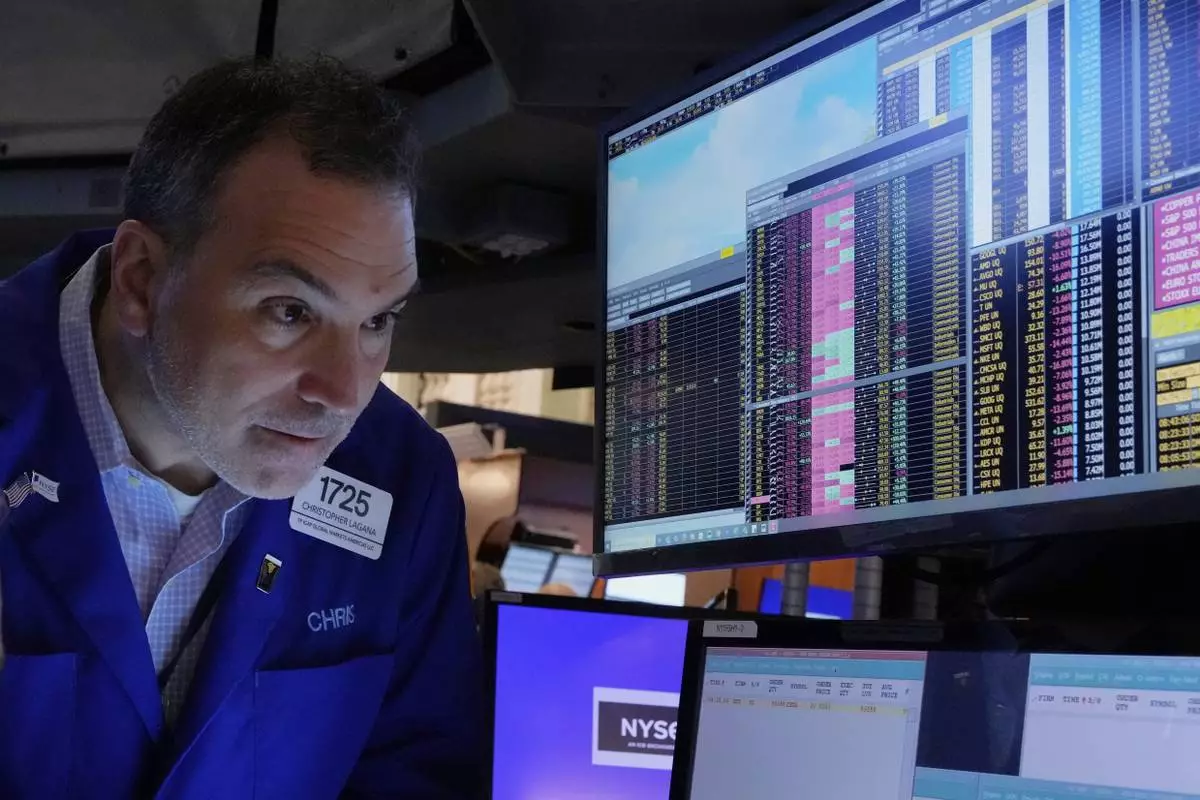
Trader Christopher Lagana works on the floor of the New York Stock Exchange, Friday, April 4, 2025. (AP Photo/Richard Drew)
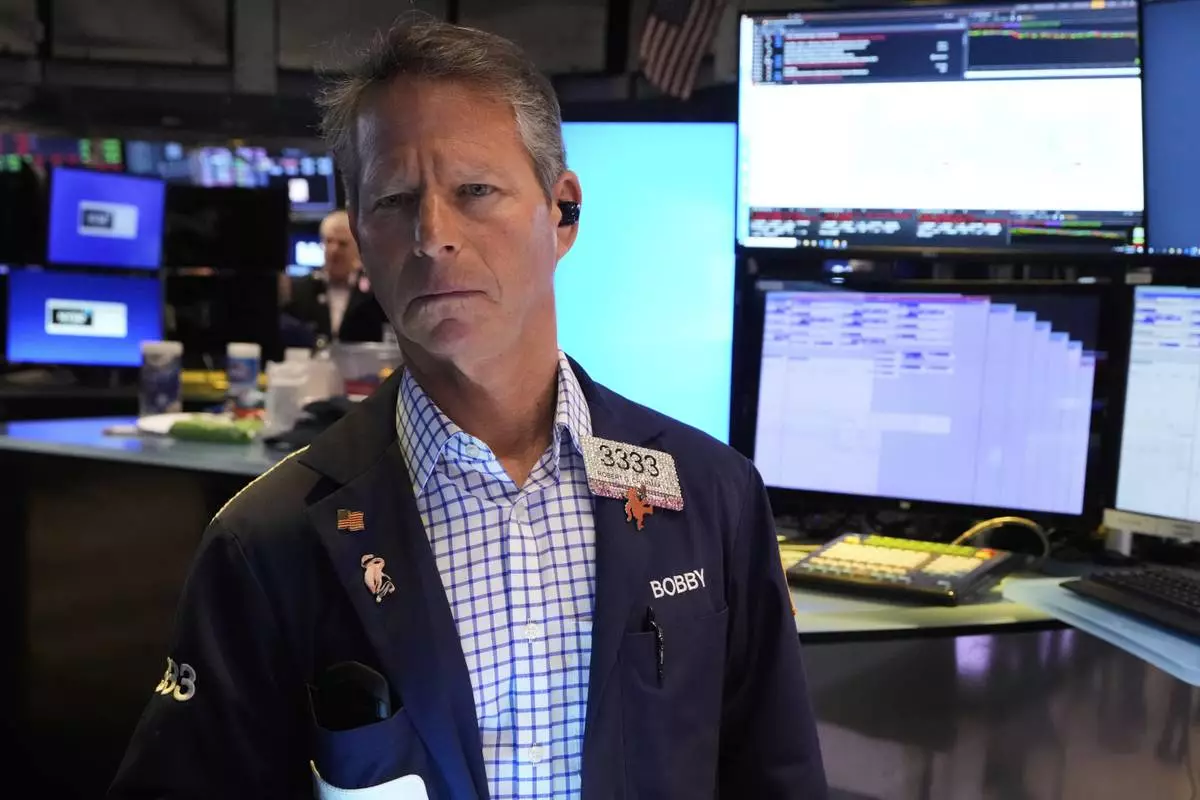
Trader Robert Charmak works on the floor of the New York Stock Exchange, Friday, April 4, 2025. (AP Photo/Richard Drew)
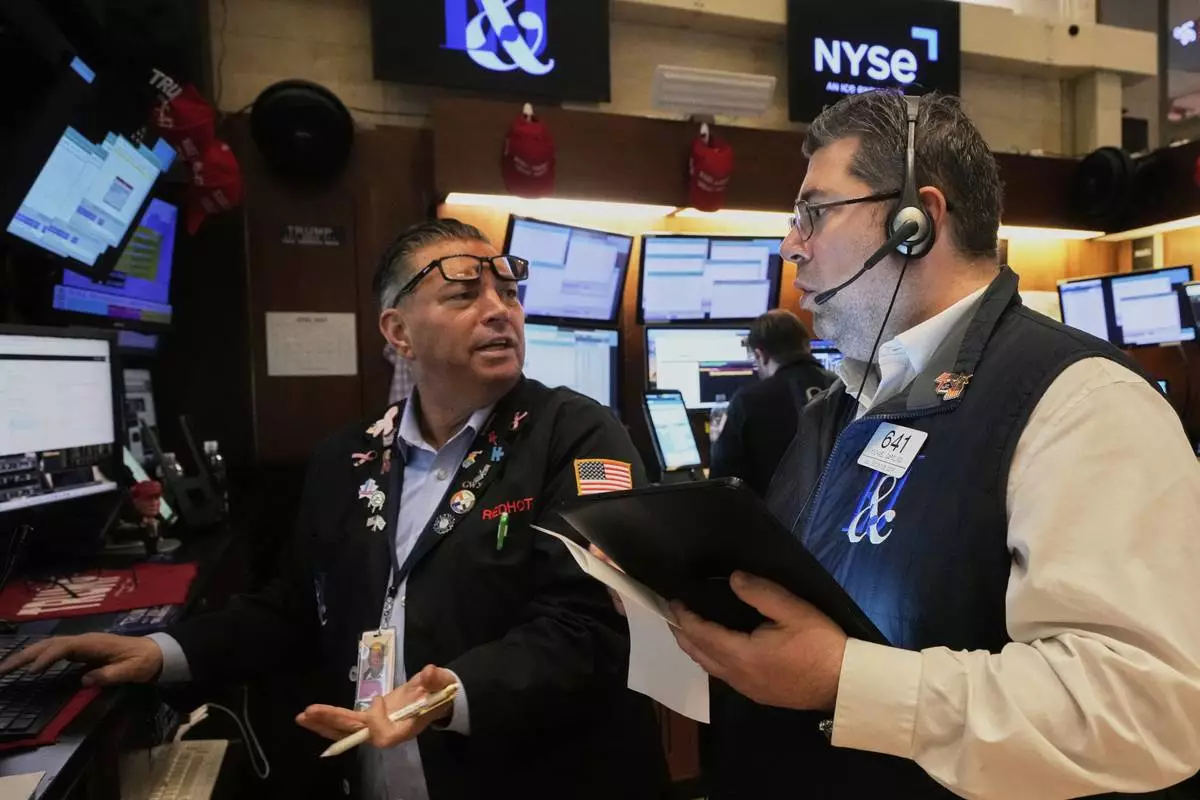
Traders Jonathan Muller, left, and Michael Capolino work on the floor of the New York Stock Exchange, Friday, April 4, 2025. (AP Photo/Richard Drew)
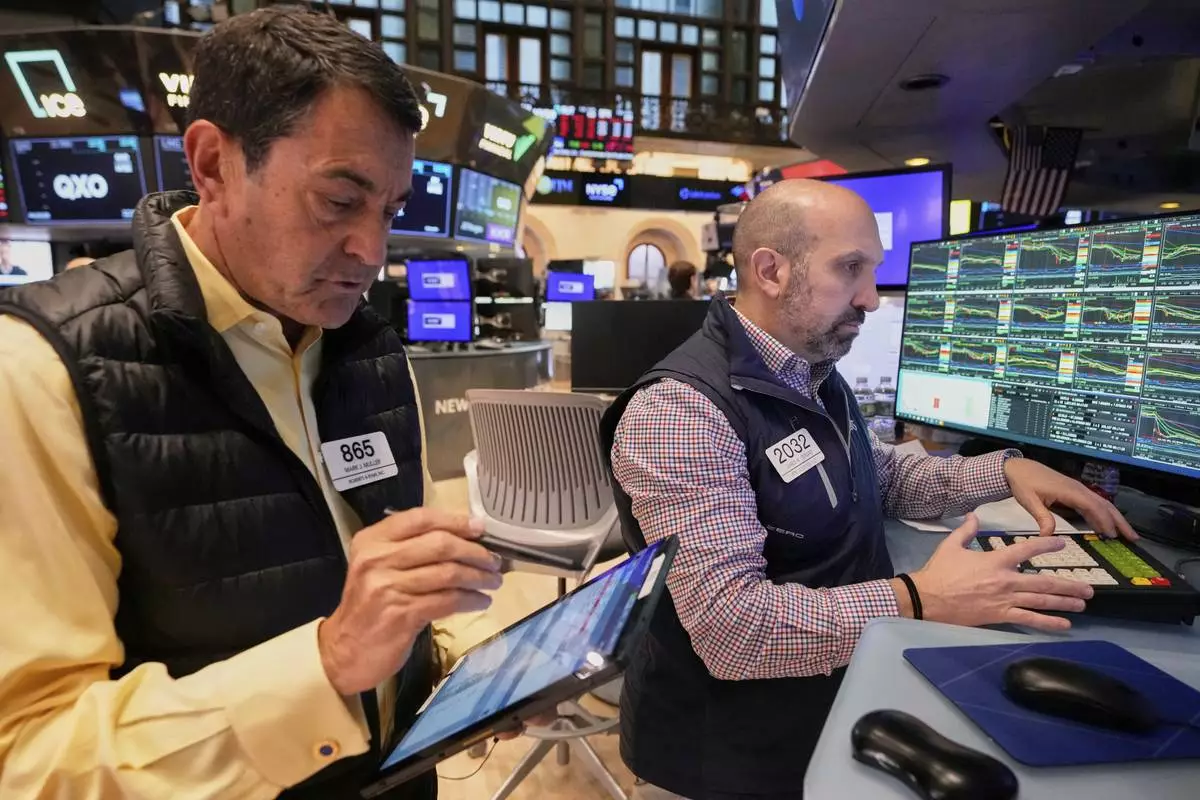
Trader Mark Muller and Specialist James Denaro work on the floor of the New York Stock Exchange, Friday, April 4, 2025. (AP Photo/Richard Drew)
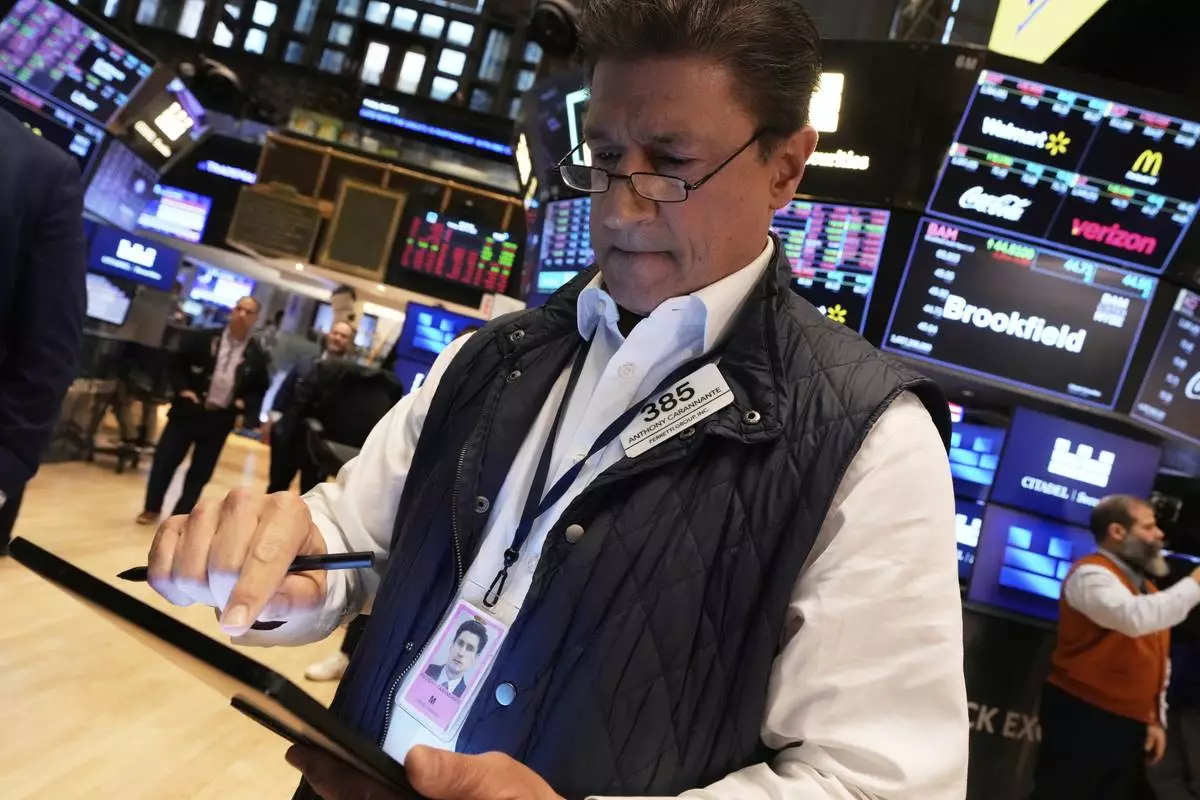
Trader Anthony Carannante works on the floor of the New York Stock Exchange, Friday, April 4, 2025. (AP Photo/Richard Drew)
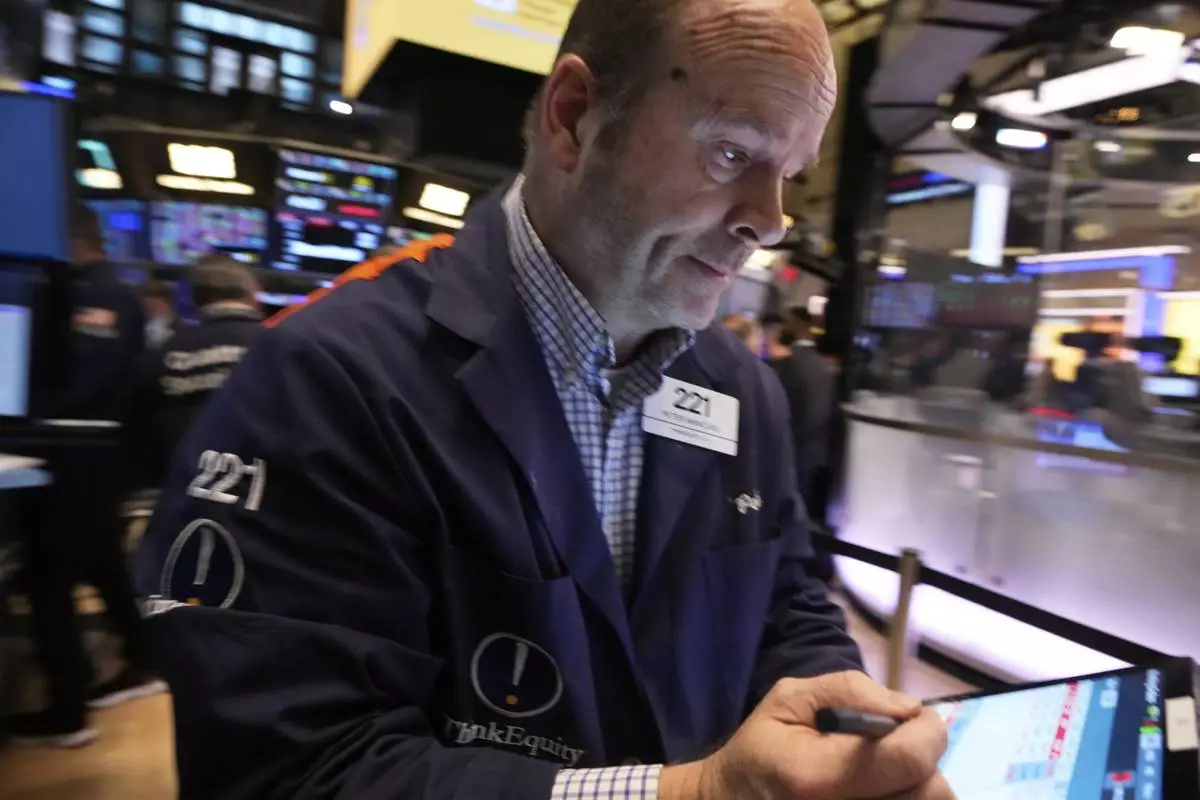
Trader Peter Mancuso works on the floor of the New York Stock Exchange, Friday, April 4, 2025. (AP Photo/Richard Drew)
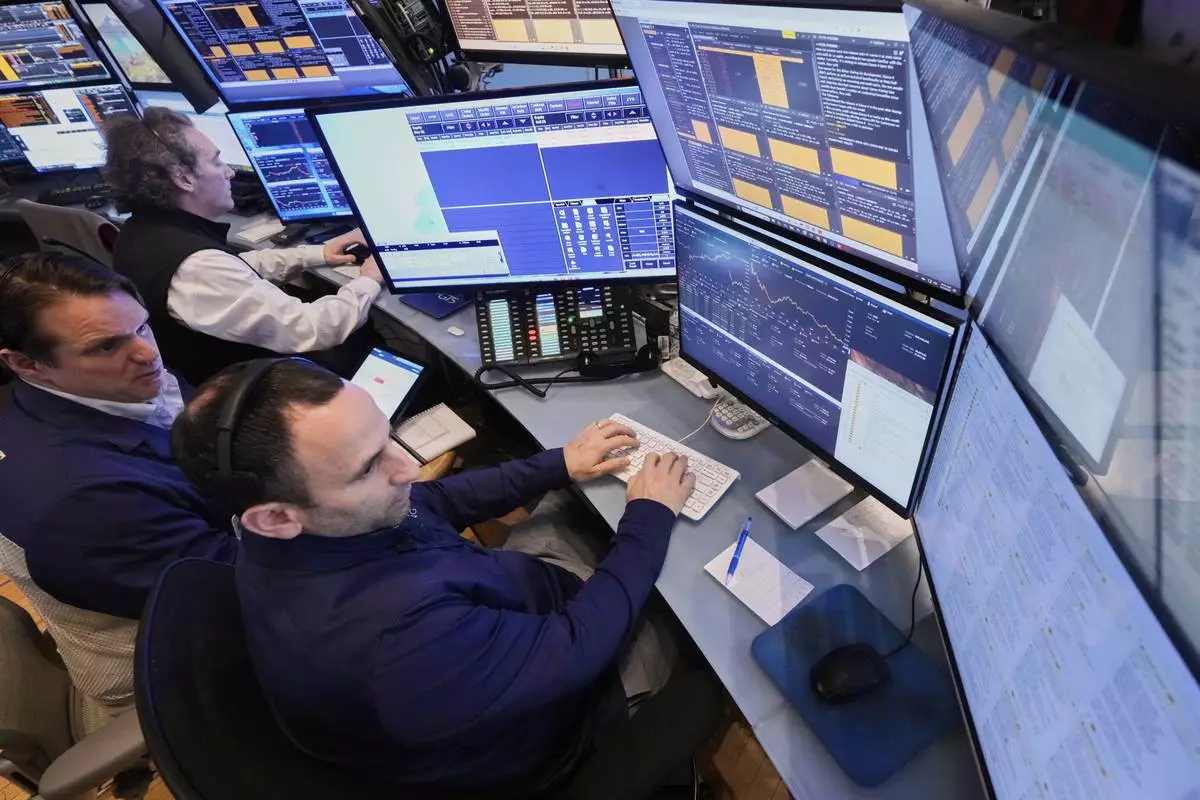
Traders work in their booth on the floor of the New York Stock Exchange, Friday, April 4, 2025. (AP Photo/Richard Drew)
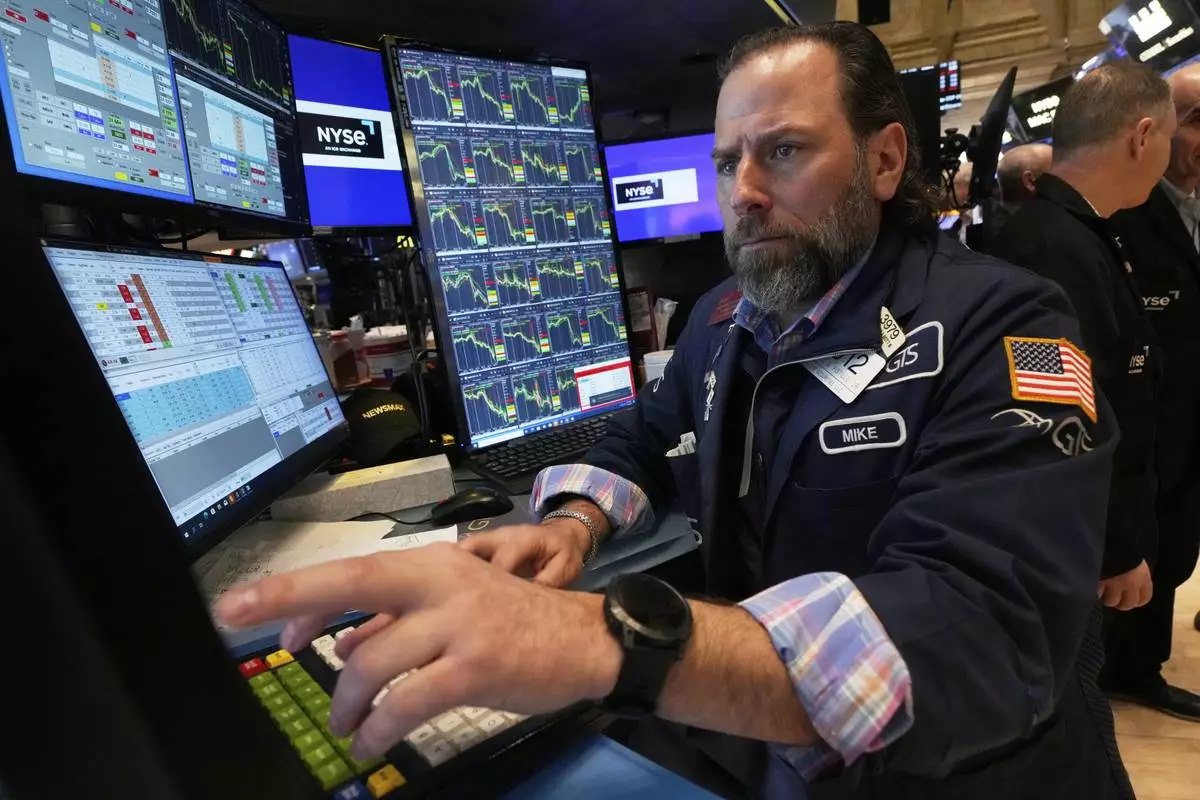
Specialist Michael Pistillo works on the floor of the New York Stock Exchange, Friday, April 4, 2025. (AP Photo/Richard Drew)
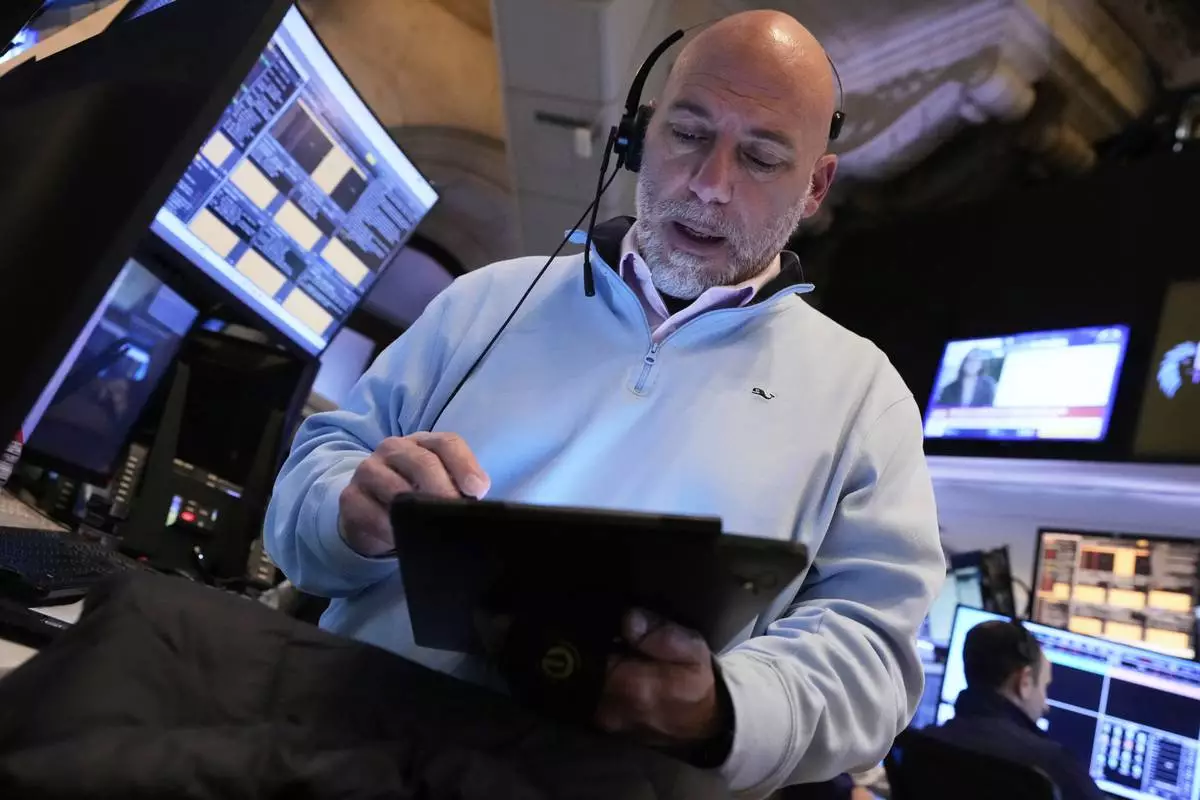
Trader Vincent Napolitano works on the floor of the New York Stock Exchange, Friday, April 4, 2025. (AP Photo/Richard Drew)

Specialist Anthony Matesic works on the floor of the New York Stock Exchange, Friday, April 4, 2025. (AP Photo/Richard Drew)
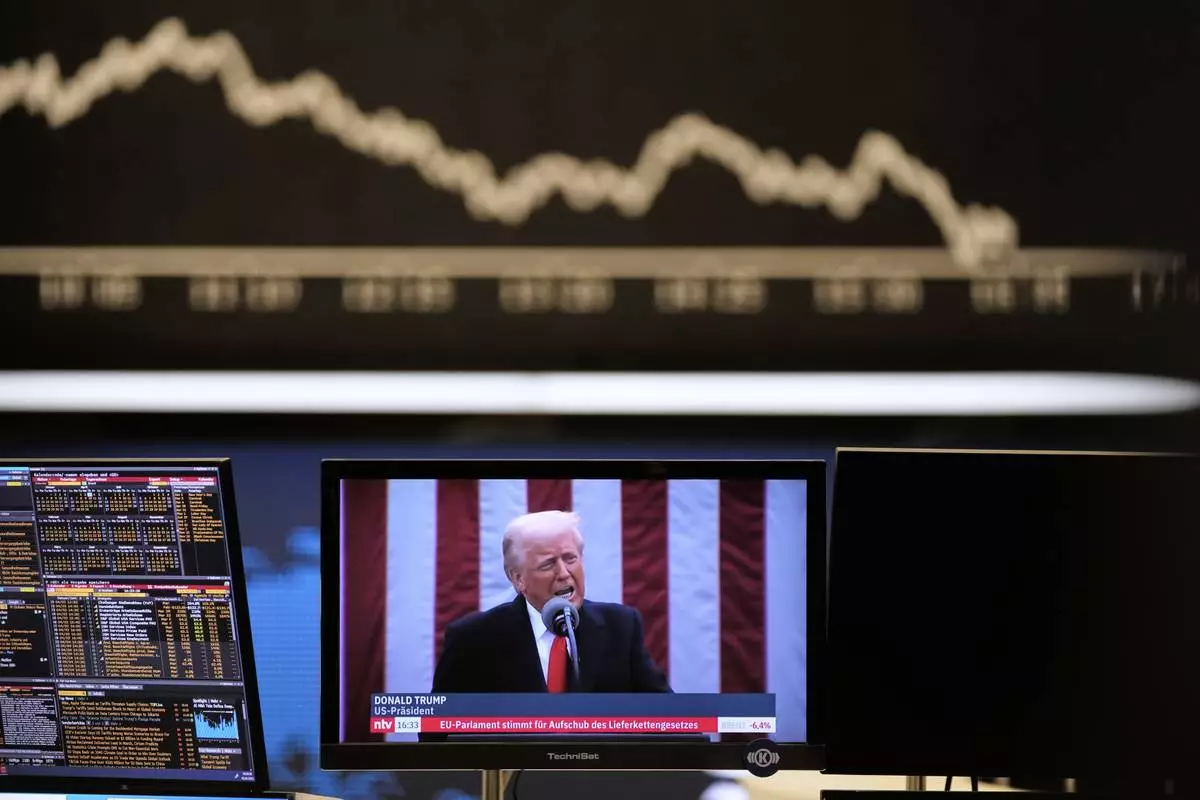
US President Donald Trump appears on a television screen at the stock market in Frankfurt, Germany, Thursday, April 3, 2025. (AP Photo/Michael Probst)
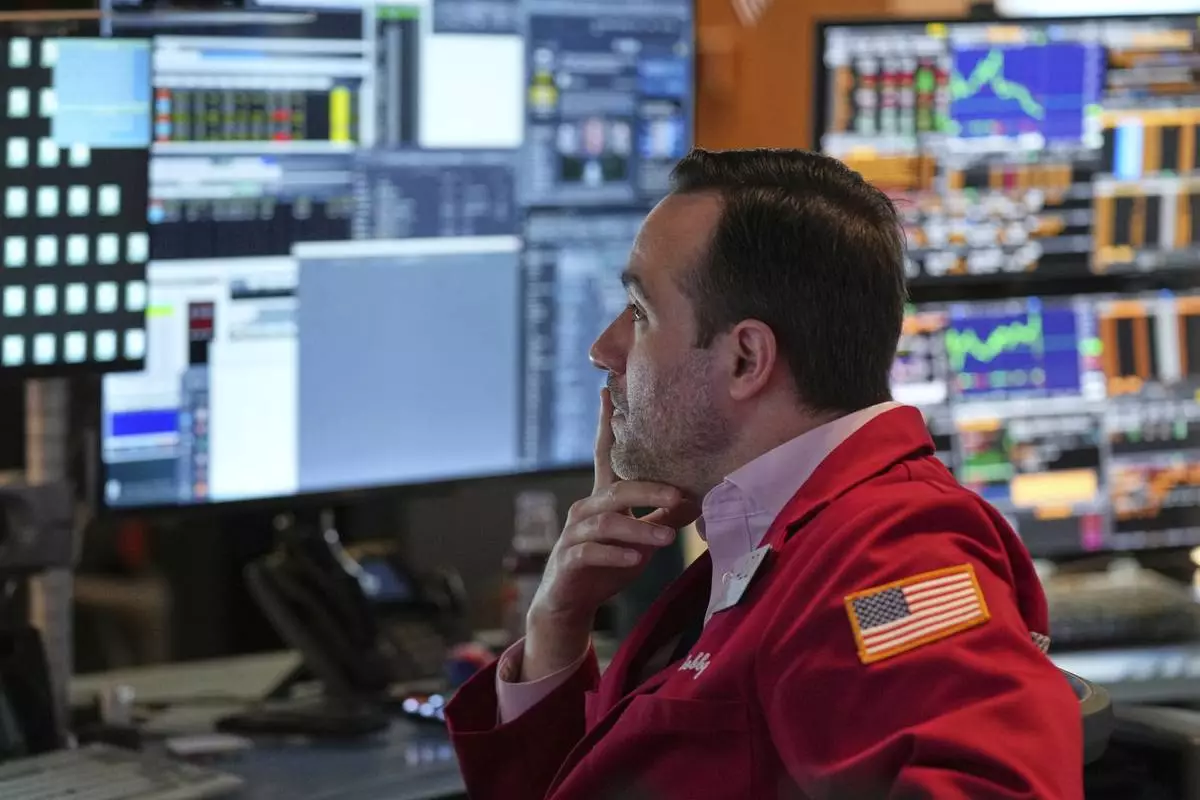
Robert Greason works on the floor at the New York Stock Exchange in New York, Thursday, April 3, 2025. (AP Photo/Seth Wenig)
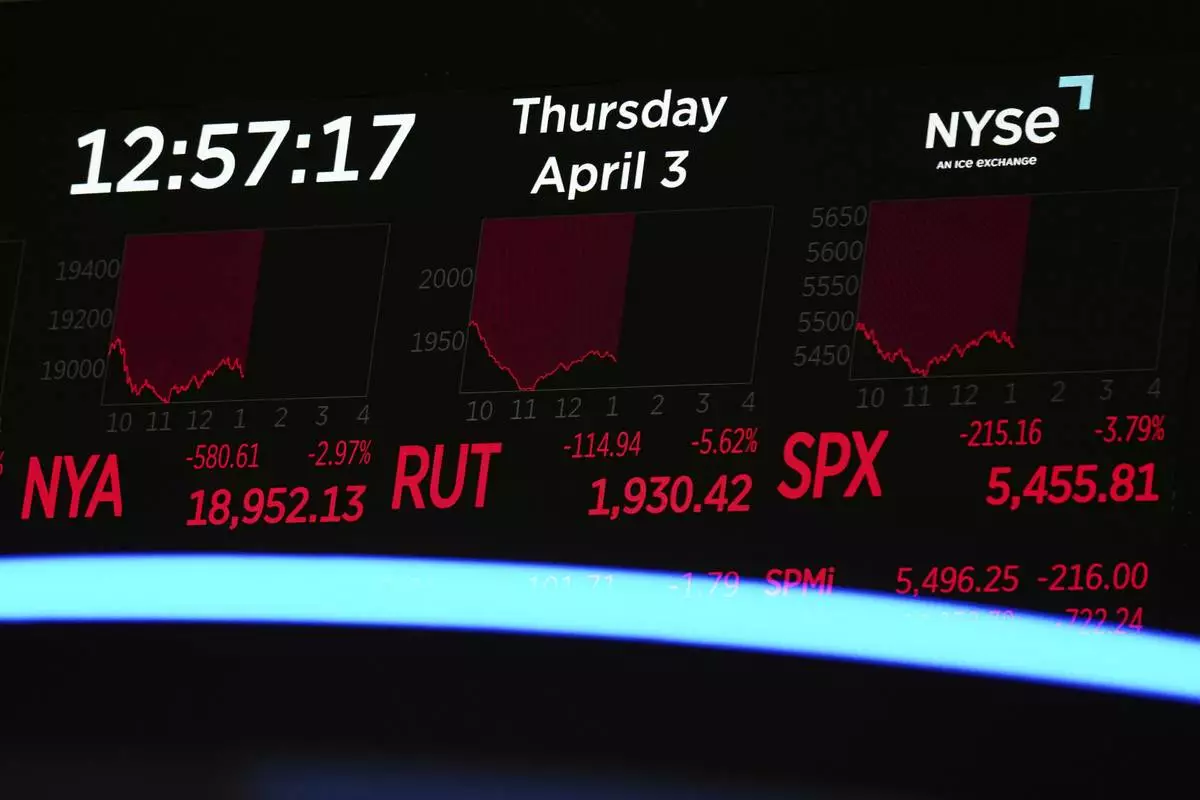
A screen displays financial news as traders work on the floor at the New York Stock Exchange in New York, Thursday, April 3, 2025. (AP Photo/Seth Wenig)
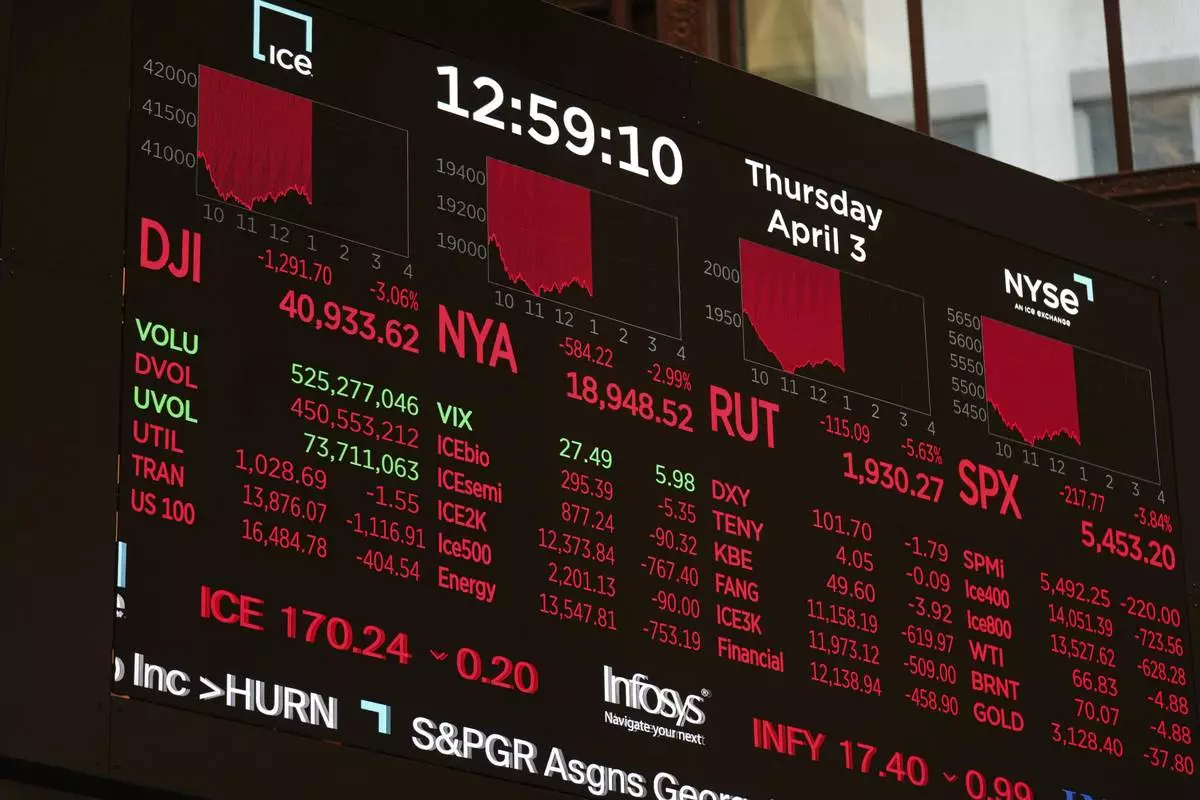
A screen displays financial news as traders work on the floor at the New York Stock Exchange in New York, Thursday, April 3, 2025. (AP Photo/Seth Wenig)












